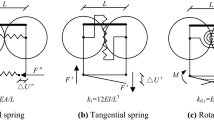Abstract
As a force-based finite element method (FEM), large increment method (LIM) has been developed in recent years. It has been shown that LIM provided prominent advantage of parallel computation with high efficiency and low time consumption for member structural system. To fully utilize its advantage in parallel computation, it is the time to extend LIM to 2D and 3D continua analysis. In this paper, a 2D finite element library with the capability of modeling arbitrary configurations is developed. Some illustrative numerical examples are solved by using the proposed library; the obtained results are compared with those obtained from both traditional displacement-based FEM and analytical solutions, which has clearly shown the advantages of LIM.
Similar content being viewed by others
References
Zhang Chun-jun. A large increment method for material nonlinearity problems [D]. Beijing: Department of Civil Endineering, Tsinghua University, 1996 (in Chinese).
Zhang Chun-jun, Liu Xi-la. A large increment method for material nonlinearity problems [J]. Advances in Structural Engineering, 1997, 1(2): 99–109.
Liu Xi-la, Wang Kai-jian, Zhang Chun-jun. The large increment method for nonlinear elastic problems of truss systems [J]. Engineering Mechanics, 2005, 22(sup 1): 7–15 (in Chinese).
Barham W S, Aref A J, Dargush G F. On the elastoplastic cyclic analysis of plane beam structures using a flexibility-based finite element approach [J]. International Journal of Solids and Structures, 2008, 45: 5688–5704.
Wang Kai-jian. Network parallel computation based on the large increment method [D]. Beijing: Department of Civil Engineering, Tsinghua University, 2004 (in Chinese).
Liu Xi-la, Long Dan-bing. A novel parallelized structural analysis method: Large increment method [C]// Proceeding of 1st Engineering Design and the Application of HPC Technique. Shanghai, China: China Civil Engineers Society, 2007: 16–29 (in Chinese).
Guo Zao-yang, Long Dan-bin, Liu Xi-la, et al. A force-based large increment method for continuum elastoplastic problems [C] // Proceedings of 17th Association of Computational Mechanics in Engineering Nottingham. UK: Association of Computational Mechanics in Engineering, 2009.
Long Dan-bin, Guo Zao-yang, Liu Xi-la, et al. An element nodal force-based large increment method for elastoplasticity [C] // Proceedings of ISCM II and EPMESC XII. Hong Kong-Macau, China: American Institute of Physics, 2009: 1401–1405.
Kaljevic I, Patnaik S N, Hopkins D A. Development of finite elements for two-dimensional structural analysis using the integrated force method [J]. Computers & Structures, 1996, 59(4): 691–706.
Author information
Authors and Affiliations
Corresponding author
Additional information
Foundation item: the National Natural Science Foundation of China (No. 10872128)
Rights and permissions
About this article
Cite this article
Long, Db., Liu, Xl. Development of 2D hybrid equilibrium elements in large increment method. J. Shanghai Jiaotong Univ. (Sci.) 18, 205–215 (2013). https://doi.org/10.1007/s12204-013-1384-3
Received:
Published:
Issue Date:
DOI: https://doi.org/10.1007/s12204-013-1384-3




